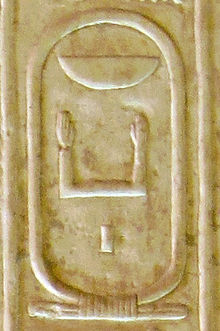Having arrived now at the III dynasty, it must be noted that the kings forming the end of the II dynasty such as Khasakemwy and the kings at the beginning of the III dynasty are shrouded in mystery. It is debated among certain Egyptologists that the kings, Horus Nebka or Horus Sanakht are not only the same king but the first ruler of the III dynasty therefore this blog will attempt to discuss the life of the pharaoh Nebka (Sanakt) and the debate from both camps concerning the position of the kings Netjyrikhet and Nebka (Sanakht). This will rely heavily on sources that seem to side with notable Egyptologists like Toby Wilkinson and Stephen Siedlmayer.
 |
| Cartouche with the name Nebka courtesy of wikipedia |
| Relief of Sanakht courtesy of ancient-egypt.org |
Those against this prevailing theory include John DeGreef, Nabil Swelim and Wolfgang Helck. They propose that the name "Nebka" in no documents and tombs that date prior to Netjyrikhet (Wildung, 1969). According to Ilario Incordino, she proposes two theories supporting DeGreef, Swelim and Helck. The first theory suggests this, "the direct succession between Khasekhemwy and Djoser, based on some architectural similarities between the Djoser Step Pyramid and the Khasekemuy funerary complex (cult enclosure and tomb), on some Djoser seals found in Khasekhemwy’s tomb, and on some Queen Nymaathapi seals in sites connected to both kings (Bet Khallaf and Abydos), bearing titles which make possible to consider her Khasekhemuy’s wife and Djoser’s mother," (Incordino, 2008). Her second theory is as follows as well, "the existence of at least one sovereign before Djoser, and it’s based on many structural and symbolic differences between Khasekhemwy’s enclosure and the Djoser pyramid (which cannot be the result of a single generation); on the presence of the name ‘Nebka’ before Djoser in almost all the historical sources; and on the existence of some great rectangular enclosures which may fill the gap in the development of royal funerary architecture between late II and early III dynasty," (Incondino, 2008).
In conclusion, all of these theories seem to have one theme woven among them which is the clay fragment with the cartouche of the hieroglyph ka. The former Egyptologists think that the clay fragment is enough evidence to support Netjyrikhet as the founder of the III dynasty whilst the latter Egyptologists either find the clay fragment invalid evidence for Netjyerkhet as the founder or as in the case of Incondino, the Queen Nymaathapi who was either the wife of Khasakhemwy or Netjyrikhet. It seems there are still more questions concerning this rather unfortunate conundrum that has pitted Egyptologists with two contradicting theories about the founder of the II and III dynasties.
References
Wilkinson, Toby. 1999. Early Dynastic Egypt
Wildung, Dietrich. 1969. Die Rolle Ägyptischer Bewussstein ihrer Nachwelt Band 1 Posthume Quellen über Könige der Ersten Vier Dynastien
Incondino, Ilario. 2008. Reign of Horus Sanakht: Possible Founder of the Third Dynasty.
No comments:
Post a Comment